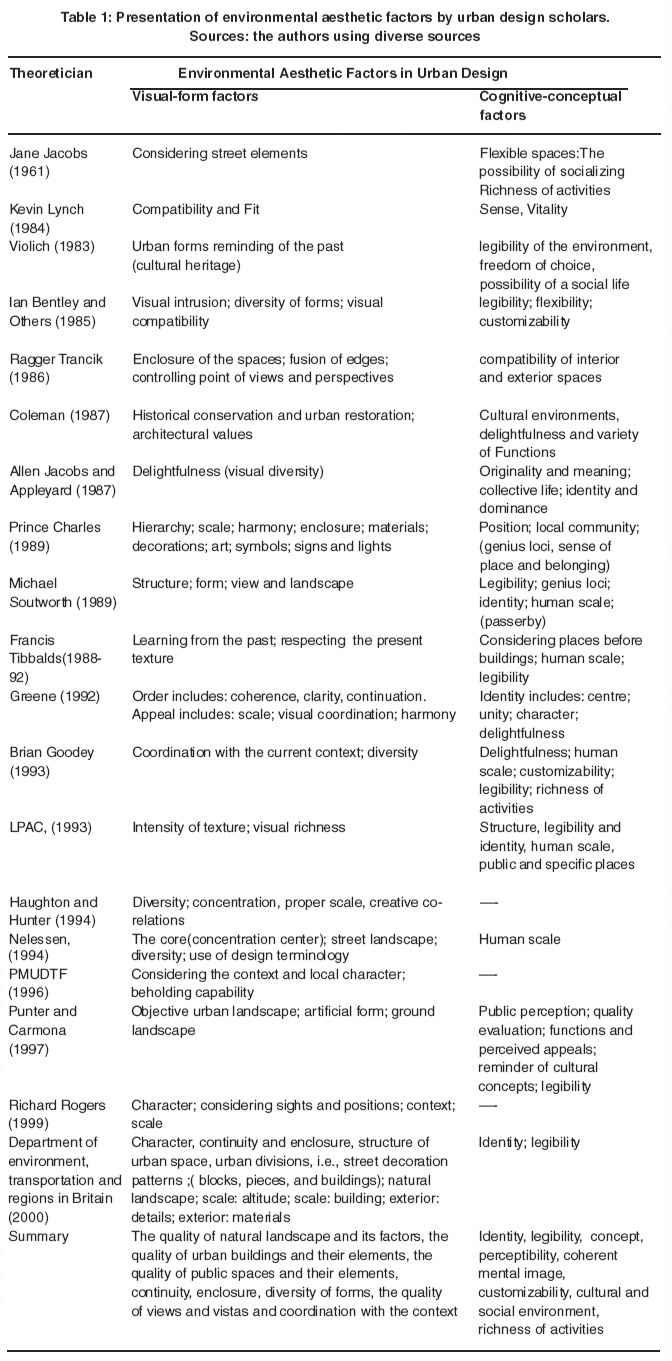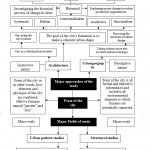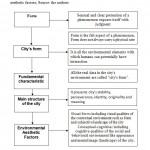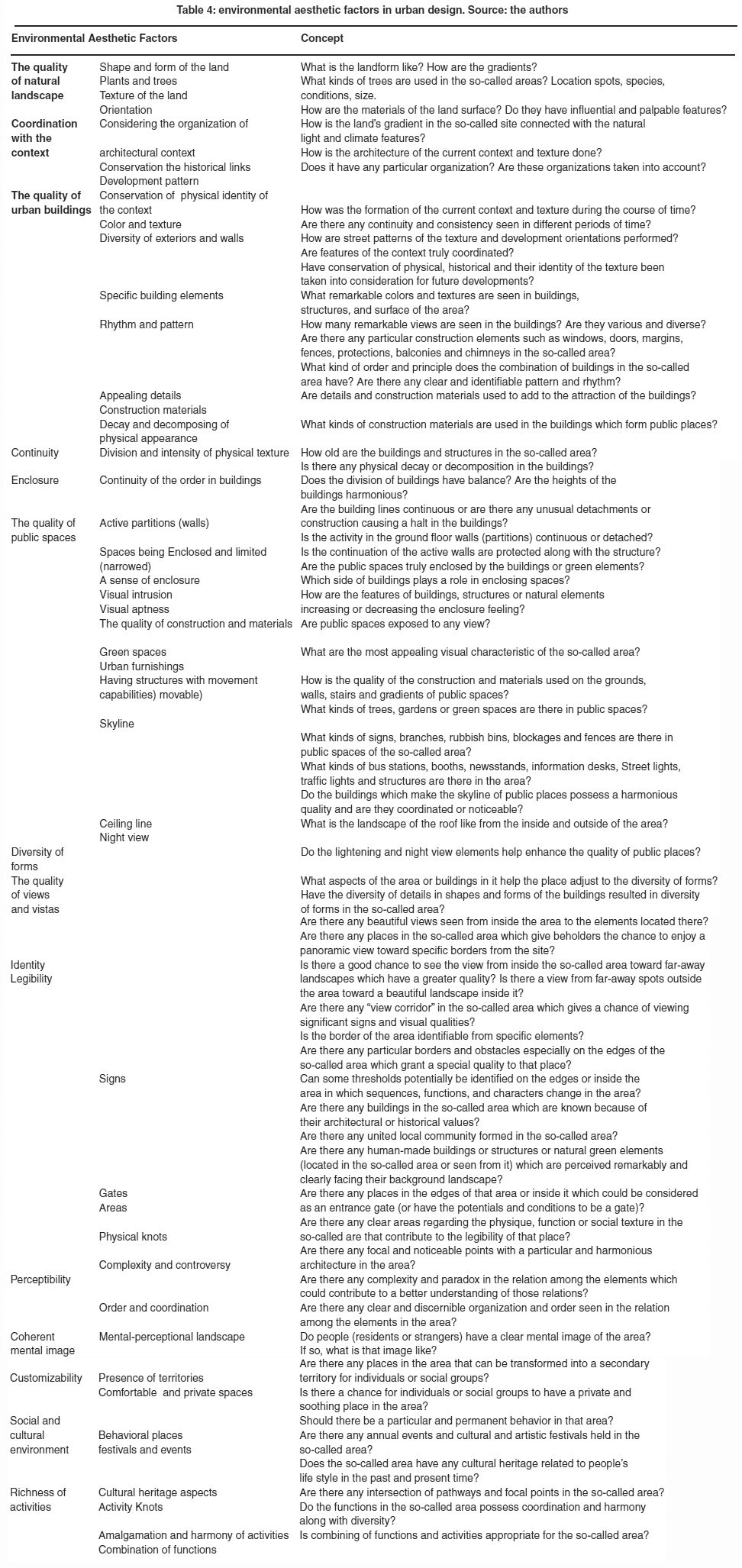Explanation of Environmental Aesthetic Factors of Urban Design
Ali Reza Sadeghi1 * , Mohammadreza Pourjafar2 , Ali Akbar Taghvaee3 and Parviz Azadfallah4
1
Urban Design at Art and Architecture Faculty of Tarbiat Modares University,
Tehran,
Iran
2
Department of Urban Design and Planning,
Faculty of Art and Architecture at Tarbiat Modares University,
Tehran,
Iran
3
Art and Architecture Faculty at Tarbiat Modares University,
Tehran,
Iran
4
Department of Psychology,
Faculty of Humanitiesat Tarbiat Modares University,
Tehran,
Iran
DOI: http://dx.doi.org/10.12944/CWE.9.2.35
Copy the following to cite this article:
Sadeghi A. R, Pourjafar M. R, Taghvaee A. A, Azadfallah P. Explanation of Environmental Aesthetic Factors of Urban Design. Curr World Environ 2014;9 (2) DOI:http://dx.doi.org/10.12944/CWE.9.2.35
Copy the following to cite this URL:
Sadeghi A. R, Pourjafar M. R, Taghvaee A. A, Azadfallah P. Explanation of Environmental Aesthetic Factors of Urban Design. Curr World Environ 2014;9(2). Available from: http://www.cwejournal.org/?p=6682
Download article (pdf)
Citation Manager
Publish History
Select type of program for download
| Endnote EndNote format (Mac & Win) | |
| Reference Manager Ris format (Win only) | |
| Procite Ris format (Win only) | |
| Medlars Format | |
| RefWorks Format RefWorks format (Mac & Win) | |
| BibTex Format BibTex format (Mac & Win) |
Article Publishing History
| Received: | 2014-07-12 |
|---|---|
| Accepted: | 2014-08-17 |
Introduction
There are two views on the concept of form. The first one looks at form versus content. Based on this old point of view, form or aspect is the shape and content is the performance of a phenomenon. On the other hand, according to the second perspective, form represents the aspect, structure, and the way content is developed, visualized, and expressed. From this standpoint, aesthetics is defined as emotional, obvious, and sensory presentation of a phenomenon which exposes itself to judgment.
Construction of a city or city’s spatial structure shows the discipline and relationship between physical elements and uses and activities in the city. This structure is formed in the urban space and from the resultant of forces affecting the city over time. However, to such thinkers as Christopher Alexander and Edmond Bacon, construction of a city as a whole can be divided into core and non-core sectors. In effect, it is the major part that forms the vertebral column of the city and represents stability, continuity, identity, originality, and meaning of the city. In other words, this core structure is responsible for transferring the city’s message to its citizens and visitors. Other parts of the city, which comprise the non-core part of it, are taken to be environments for showing diversity, freedom, authority, and change. At this time, it appears that if we consider the urban form as all elements of natural and human-made environment that surrounds human being, which men can potentially connect with it, the core structure of the city can be a fundamental characteristic of the urban form. Since, the main structure of the city is comprised of such elements as the key axes of communication, major open spaces, public buildings, etc., with which people are always connected. (Picture1)
On the other hand, environmental aesthetics is one of the two or three important areas of aesthetics which have been taken into consideration since the second half of twentieth century. The most significant subjects, with whom environmental aesthetics is involved, are those related to understanding of the universe aesthetics and world aesthetics whose constituents are not merely objects and phenomena. They are, rather, bigger elements found in the environment. Therefore, the domain of environmental aesthetics goes beyond the limited borders of the art world and human understanding and broadens to aesthetic understanding of natural and human-made artificial environments which are influenced by the presence of men. In this regard, it seems that in this era analysis of environmental aesthetics characteristics of urban form is more essential than ever. Since, today with expansion of cities, implementation of several projects in such human societies and ever increasing changes in form of the city and main structure of metropolises, the need for analysis and explanation of the effects from implementation of urban projects and plans on citizens and environment is sensed more than ever. Indeed, analysis of human-made environment and investigation of urban plans’ impact on human being and environment are the main responsibilities of urban designers to meet high spectacular goals such as improvement of the quality of human-made environment.
Materials and Methods
Through reviewing the previous researches in fields of form aesthetics and urban landscape in the past half century, it is evident that discussions about aesthetics in this field have gone through changes from a visual-artistic standpoint into an issue with perceptional-meaning tendencies. This is quite clear in the move from picturesque style to a conceptual tendency in the aesthetics of form and city landscape. picturesque which had an architectural focus on the artistic-visual aspects of landscape such as the plurality and diversity, humane scale, naturalism and organic order in form and color combination, has been popular by a group of scholars including Sitte, Gibberd, Halprin.1,2 Despite modernists who advertise “object-like architecture”, Collin takes “the art of communication” more into account, combines the Genius Loci (sense of place) with movement and brings about the constant views of the urban environment,3 On one hand, Collin’s approach, however original and moving, is faced with criticism in the field of perception of beauty due to its focus on personal perception and feeling of an urban landscape experience. On the other hand, urban aesthetics do not have the capability to compete with Jacobs and Newman’s approach which have been developed in the 60s and 70s in social-behavioral science.4,5 In addition, it could not fit in with the phenomenological theories of Relph and Jakson6,7 or with theoretical and philosophical factors of Norberg Schulz in the following decade8
 |
Table 1: Presentation of environmental aesthetic factors by urban design scholars. Sources: the authors using diverse sources Click here to view table |
These new thought trends and considerations to different dimensions of urban design weakened discussions about aesthetics and particularly those related to picturesque and Collin’s approach. Gradually, urban landscape aesthetics has moved its focus from a subjective, sentimental and professional attitude related to visual qualities such as form, color and context to a cognitive-perceptional study of urban landscape. For this reason, theories of form aesthetics and urban landscape are discussed more in psychological studies of the environment than in the field of urban design. Such theories include Appleton’s survival theory in beauty preferences that seeks a relation between an appropriate condition for survival and beauty9. In his evolutionary theory, Stephen Kaplan puts his focus on the obedience of people and the degree they are familiar with landscape, orientation, and obtaining new data in beauty preferences.10
Regarding what was said, explanation of environmental aesthetic elements of urban form and spaces seems essential. Therefore, the main objective of this text is to investigate the effects of environmental aesthetics elements of urban designing on formation of the main part of the city (as the fundamental characteristics of the urban form). Since, human is always interacting with surrounding environment and takes feeling, understanding, and intuition of its different aspects through his senses, especially sense of sight, into consideration. In fact, these feeling, understanding, and intuition of citizens of superficial aspects of the main structure form of the cities shape the ground for formation of coherent mental picture and good memory in them. In addition, with respect to urban design and environment quality improvement related issues, enhancement of objective and subjective aesthetic qualities (visual-form and conceptual-cognitive qualities) is very important in urban public realms, and it seems to have a fundamental role in form of legible and original cities.
This comparative article explains the environmental aesthetic elements that are affecting the formation of main structure of the cities during the history of urbanism history (Teotihuacan, Beijing, Athena, Rome, Paris, Washington, Brasilia, and Isfahan) to pave the way for analysis of environmental aesthetics and improvement of contemporary cities’ quality. For this purpose, the present study employs analytical-descriptive research methods, and literature, references, and visual documents reviews.
 |
Figure 1: approaches about city's form. Source: the authors using different sources Click here to View Figure |
Environmental Aesthetics in Urban Design
Theoreticiansof aesthetic theories are divided into three general groups including pre-modern era, modern and postmodern. The pre-modern period dates back to the times before the renaissance, i.e. the time when arts were serving the religion. (Those arts are also called traditional art). There was not much innovation and creativity in that period. Everything was reproduced in a traditional way and the artist did not have any opportunity to express his own imagination. Natural beauty (inspired by the nature) is prior to artistic and creative beauty.11 The modern period emerges when tradition is expelled and everything is renewed. This renewing starts with the emergence of new territories and fields for human beings. Modern thought is actually rational thinking, self-centered and regards objective thinking, pragmatism, emotionalism and individual intuition and is, as a result, a kind of creativity and innovation which finally values the work’s integrity and independence. When defining the modern aesthetics, we can refer to Frank Lloyd Wright and Le Corbusier who are two major modernist architects. Wright takes the concept of beauty in organic architecture from nature and believes that principles and order are the basic factorsfor an evolved beauty. Beauty is a proportional display as color, line and form. This proportion is so honest as if forms and colors seek their existential cause in displaying an eternal design. Here, it should be noted that it is not only the form and color that Wright considers as important in beauty; rather, he values the systematic nature, order, balance, and the hidden integrity of nature, and Le Corbusier as a pioneer of modern techniques utilizes forms which are products of modern engineering.12 Quite the opposite, the postmodern era focuses on plurality, does not give any credit to the work’s independent nature, takes non-artistic issues such as social-political status into account, and finally pulls the aesthetic value of a work of art to the edges.Postmodernbeauty is a plural beauty that is good for every “cultural taste” and for diverse impressions of a good life.13 But, the present era in which capitalism is dominant in relations between human and his environment, aesthetic values are being neglected as a result of economic relations and also due to the necessity of a benefit-seeking attitude toward natural and artificial environment surrounding people. Therefore, to challenge this narrow-minded way of thinking toward the relation between human and his surrounding environment, new concepts are put forward in aesthetics which are in fact framed in an environmental aesthetics. Indeed, environmental aesthetic is a concept which should not be merely limited to contexts of place, ethics and spiritual thoughts, but rather, it should inevitably be implemented in a social, economical and political body.Environmental aesthetics is a multi-senseand widespread engagement with the environment of which human beings are the main components. In environmental aesthetics, when a sublime feeling reaches its peak, experience of beauty can be truly strong and contain valuable mental stimulations. In this kind of aesthetics, beauty or the sublime can be a routine and typical pleasure, present in human being’s surroundings the highest level of which is in an environment filled with integrity, complexity, and mystery. In Whitehead’s aesthetic theory, it is stated that size or diversity of forms along with quality of intensity and comparative magnifying, needless to a variety of qualities, are able to generate a powerful environment. In fact, in environmental aesthetics, qualities of integrity, complexity and mystery are combined together in order to give meaning to the beauty and sublime in human’s surrounding environment.14 In respect to this, Schulz makes a connection between architecture, place and cultural identity and believes that experience of the place is actually the experience of the meaning of the place; and experience of beauty in an environment is indeed an appreciation of meaning8. In his book, “The Image of the City”, Lynch considers visualizing space and time as the basis to reach an understanding of environment, and thus, believes that all of these elements together have a close affinity with beauty.15 In his normaltheory of the good form of a city, he points at insufficiency of concepts such as harmony, diversity, and order present in an object or landscape and believes that one should begin with cognitive images and users’ priorities and see the person and place as a whole16. Boyer also discusses the role of collective memories and semantic dimensions in achieving the pleasure of an environment and understanding of its beauty17
 |
Table 2: Explanation of the role of aesthetic - form factors in the main structure of cities. Source: the authors Click here to view table |
From the environmental aesthetics point of view, an urban space is a beautiful space in which aesthetic criteria are involved in its construction and that means urban designing is actually the very creation of a beautiful urban space. There are two schools of thought in understanding beauty. One takes perceptional elements in time of perception into account and the other discusses non-perceptional elements such as culture, scientific knowledge and patterns as the influential factor.
 |
Figure 2: engagement of the city's form, main structure and environmental aesthetic factors; Source: the authors Click here to View Figure |
Explanation of Environmental Aesthetics Factors in Urban Design
As mentioned above, nowadays, considering environmental aesthetics, explanation of its factors and utilizing them in analyzing urban spaces is of great significance in urban design. Authors of this article believe that environmental aesthetic factors in urban design are divided into two groups that are, visual-form qualities and cognitive-semantic qualities (conceptual-cognitive qualities). Visual-form elements include visual qualities of the contextual environment such as form and subjective landscape of the city and conceptual-cognitive elements include cognitive qualities of the social and behavioral environment like image and mental landscape of the city.
Furthermore, many of urban design scholars who have explained the qualities of a good urban design through a normal approach, have focused on taking environmental aesthetic factors into consideration in urban design. In table 1, both visual-form and conceptual-cognitive qualities of environmental aesthetics discussed by some urban design scholars are presented.
Table 3: Explanation of environmental aesthetic factors of the city's form through a comparative approach. Source: the authors
| Explanation of visual-aesthetic evaluation factors of the main structure of the cities ( high impact; medium impact; low impact ) | |||||||||
| The suggested factors | how the factors impact the formation of cities | ||||||||
| Teotihuacan | Beijing | Athens | Rome | Brasilia | Paris | Washington | Isfahan | ||
| Visual-form factors | The quality of the earth’s natural landscape and its elements | • | •• | • • • | • • • | • | • • • | • • • | • • • |
| The quality of urban buildings and their elements | •• | • • • | • • • | • • • | • • • | • • • | • • • | • • • | |
| The quality of public spaces and their elements | •• | • | • • • | • • • | • • | • • • | • • • | • • • | |
| Continuity | • • • | • • • | • • • | • • • | • • | • • • | • • • | • • • | |
| Enclosure | • • • | • • • | • • • | • • • | • • | • • • | • • • | • • | |
| Diversity of forms | •• | • • • | • • • | • • • | • • • | • • • | • • | • • • | |
| Quality of views and vistas | • • • | • • • | • • • | • • • | • • • | • • • | • • • | • • • | |
| Coordination with the context | • • | • • • | • • • | • • • | • | • • • | • • • | • • • | |
| Cognitive-conceptual factor | Identity | • • • | • • • | • • • | • • • | • • • | • • • | • • • | • • • |
| Eligibility | •• | • • • | • • • | • • • | • • • | • • • | • • • | • • • | |
| Concept | • • • | • • • | • • • | • • • | • • | • • • | • • • | • • • | |
| Perceptibility | • • • | • • • | • • • | • • • | • • | • • • | • • • | • • • | |
| Coherent Mental image | • • • | • • • | • • • | • • • | • • | • • • | • • • | • • • | |
| Customizability | • | • | • | • • • | • | • • | • • | • • | |
| Social and cultural environments | • | • | • • • | • • • | • | • • • | • • • | • • • | |
| Richness of activities | • | • | • • • | • • • | • • | • • • | • • | • • • | |
Discussion and Conclusion
It has been said that the main structure of every city is a fundamental characteristic of the city’s form which has a remarkable role in that city’s stability, continuity, identity, originality and meaning. It has also been noticed that environmental aesthetic factors have always played a vital role in the formation of a city’s structure. (Picture 2)
Moreover, in this research, analysis of aesthetic factors presented by urban design scholars has led to the division of suggested environmental aesthetics of city’s form into two groups, namely, visual-form factors and cognitive-conceptual factors. These factors include:
- Aesthetic-form factors including: the quality of natural landscape and its elements, the quality of urban buildings and their elements, the quality of public spaces and their elements, continuity, enclosure, diversity of forms, the quality of views and vistas and coordination with the context
- Cognitive-conceptual factors including: identity, legibility, concept, perceptibility, coherent mental image, customizability, social and cultural environment, richness of activities.
 |
Table 4: environmental aesthetic factors in urban design. Source: the authors Click here to view table |
Besides, despite having different patterns of city structure and belonging to diverse civilizations, most ancient cities’ form in different parts of the world have some things in common, and thus, through examining them, we can find certain principles about their shaping, survival and restoration of the main structure of the city. However, it seems that one common reason of the survival and restoration of these cities is use of environmental aesthetic factors, namely, visual-form factors and cognitive-conceptual factors, in urban design and in organizing these cities’ form. In table 2, the main structure of some important cities and the role of environmental aesthetics in their formation are explained. To explain these characteristics, mostly visual-form factors are taken into account since they provide the context for the formation of cognitive-conceptual factors.
In addition, in table 3, through a comparative study of the main structure of the cities discussed above and based on the suggested factors, the aesthetic-visual evaluation factors of the structures have been explainedthoroughly. (Table 3)
Regarding table 3, it seems that most of the suggested environmental aesthetic factors are appropriate for evaluating the main structure of the cities. In addition, apparently, among visual-form aesthetic factors, the quality of views and vistas are of more significance. Moreover, among cognitive-conceptual factors, identity and legibility are very vital to analyze the environmental aesthetic forms of the city, while, it seems that among the cities discussed above, form of the main structure of Paris and Washington have used visual-form quality of the environmental aesthetics more than any other city.
References
- Gibberd, F., “Town Design”, London: Architectural Press, (1955).
- Halprin, L., “Freeways”, New York, Reinhold, (1966)
- Cullen, G.,” Townscape”, NY: Reinhold, (1961).
- Newman, O., “Defensible space: people and design in the violent city”, London, Architectural Press,(1972).
- Jacobs, J., “The Death and Life of Great American Cities”, New York: Random House, (1961).
- Relph, E. ,”Place and Placelessness”, London, pion, (1976).
- Jakson, J. B., “The necessity for ruins”, Amherst;University of Massachusetts Press, (1980).
- Norberg-Schulz, C., , “Genius Loci: Paysage, Ambiance, Architecture”, Brussels; Mardaga, (1981).
- Appelton, J., “Prospects and refuges revisited” Landscape Journal 8; 91–103, (1984).
- Kaplan. S., “Aesthetics, affect, and cognition: environmental preferences from an evolutionary perspective”, Environment and Behavior 19, (1987).
- Zamiran, Mohammad, “Philosophica Thinking in the Turn of the Second Millennium”, Hermes Publications, Tehran, (2002) [In Persian]
- Grutter, Jorgkurt, “Aesthetics in Architecture”, Trans: Jahanshah Pakzad, Second edition, Shahid Beheshti University Press, Tehran, (2005) [In Persian]
- Jencks, Ch., “What Is Post-Modernism?”, NY, St. Martin’s Press, (1986).
- Bell, S., “Landscape: Pattern, Perception, and Process”, London, E & FN Spon Press, (1999).
- Lynch, K.,”The image of the city”. Mass, MIT Press, (1960).
- Lynch, K.,”Good city form “, Mass, MIT Press, (1984).
- Boyer, Ch., “The city of collective memory”,MIT press, USA, (1994).
- Bacon, E., “Design of Cities”, NY, Penguin Books, (1976).
- Bentley, I; Alcock, A.; McGlynn, S; Murrain, P. Smith, G., Responsive environments: A manual for designers. Oxford, Butterworth Architecture, (1992).
- Carmona, M. et al., Public spaces – Urban places: The dimensions of urban design. Architecture Press, (2003).
- Encyclopedia of aesthetics, Editor in chief: Michael Kelly, vol (2), entry of formalism, pp 213-225, oxford, (1988).
- Kaplan. R. and Kaplan. S., “The Experience ofNature: A Psychological Perspective”, CambridgeUniversity. Cambridge,UK, (1991).
- Porteous, J.D., Environmental Aesthetics: Ideas, Politics and Planning, London, Routledge, (1996).
- Nasar, J., “Urban Design Aesthetics- The Evaluative Qualities of Building Exteriors”, Environment and Behavior, 26(3): 377-401, (1994).






